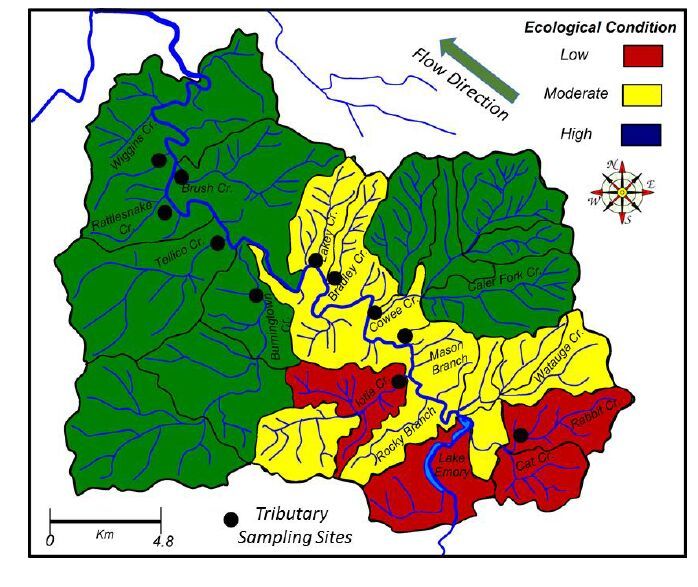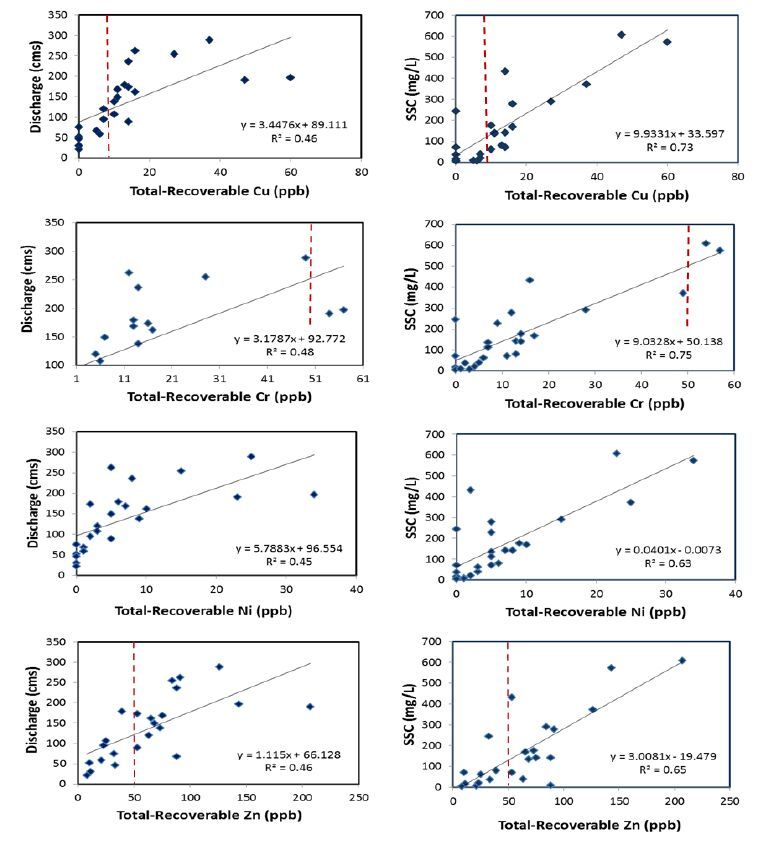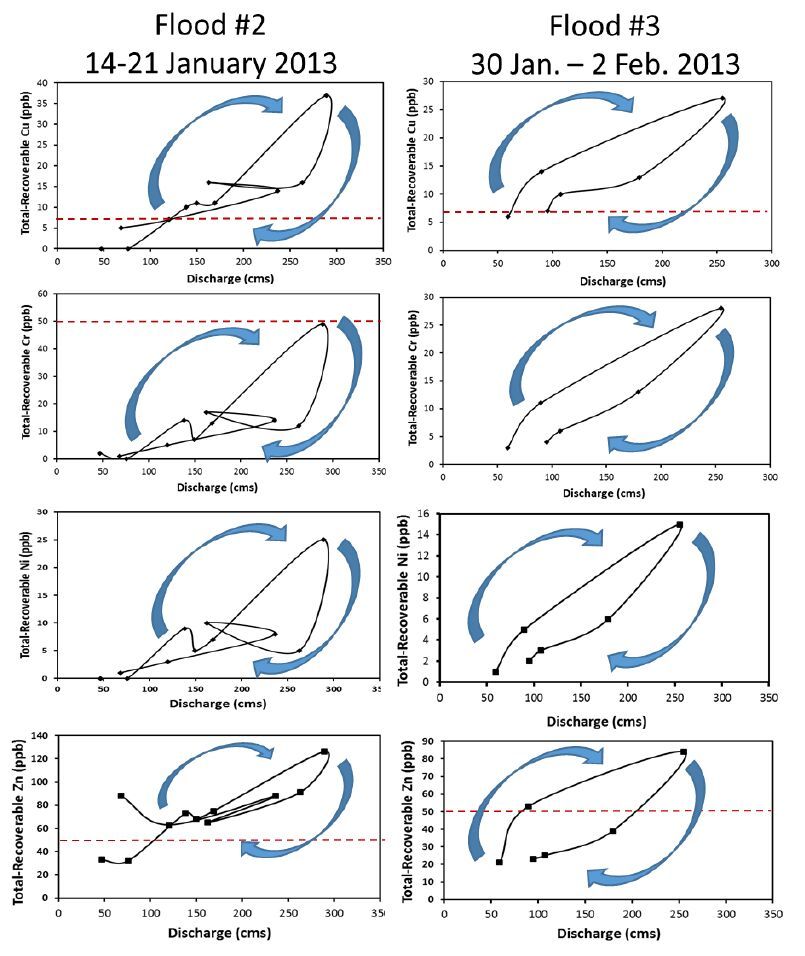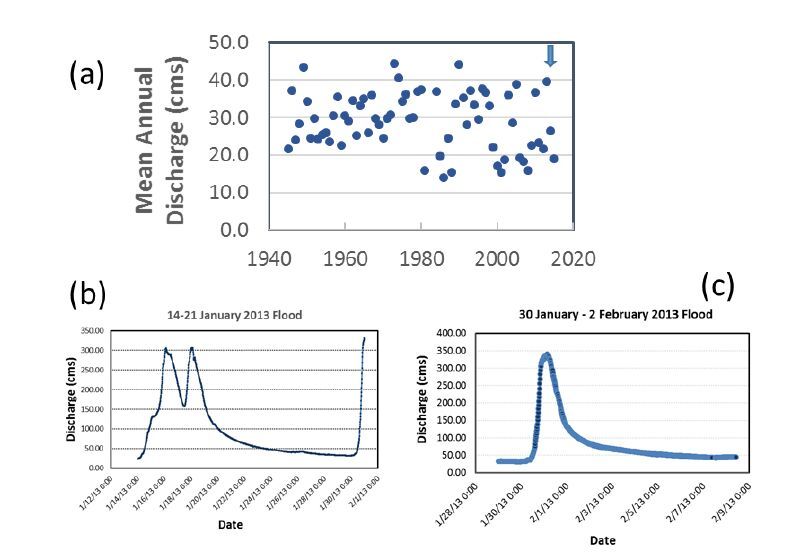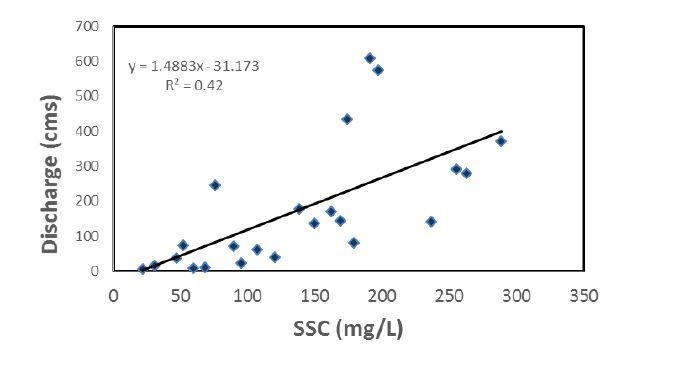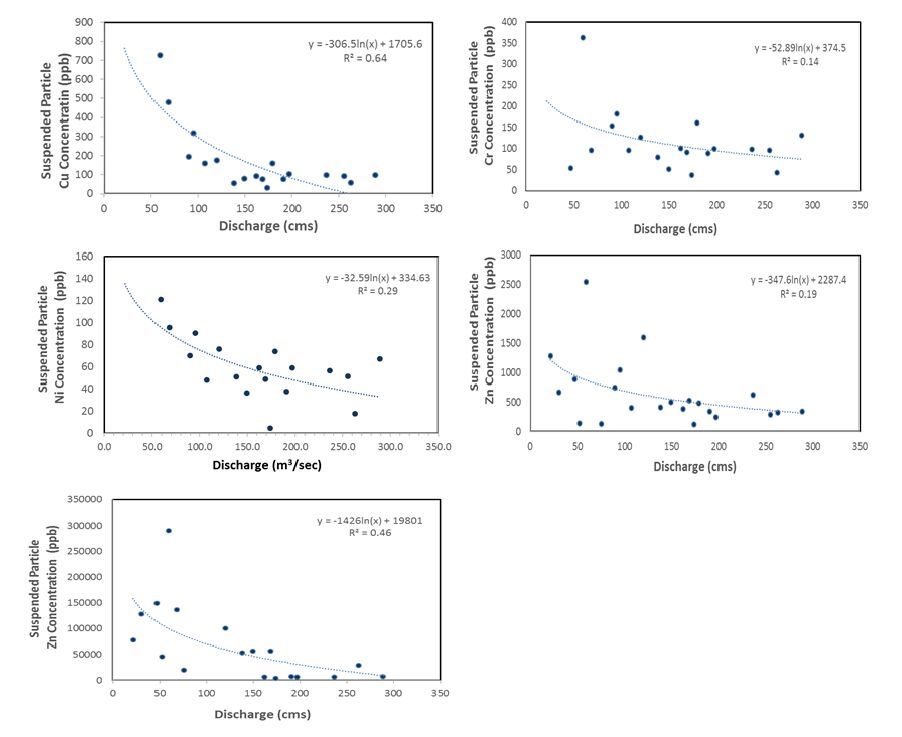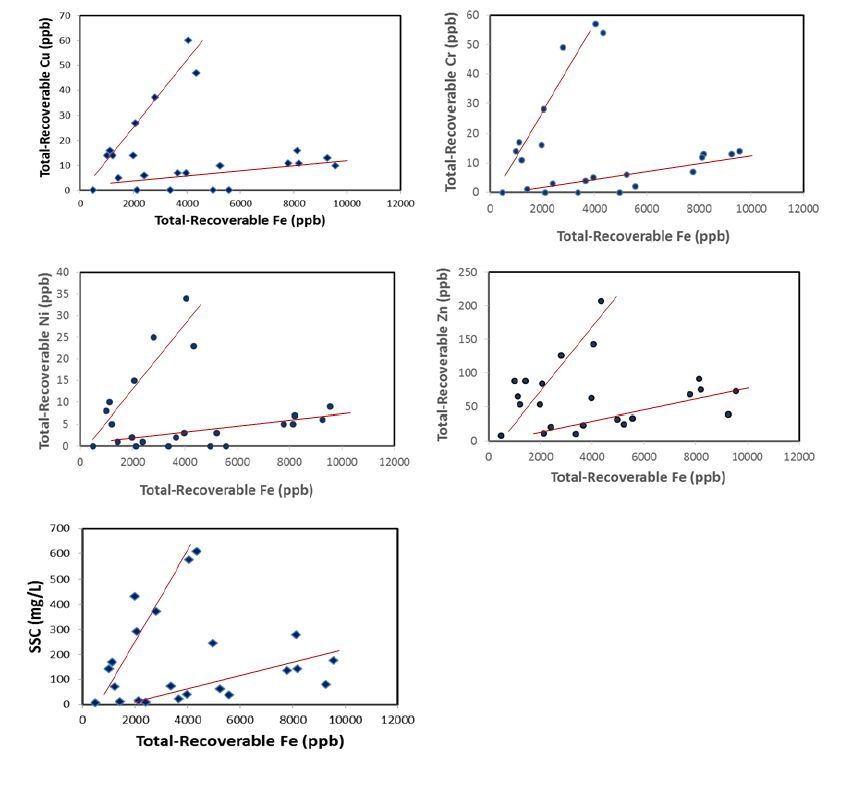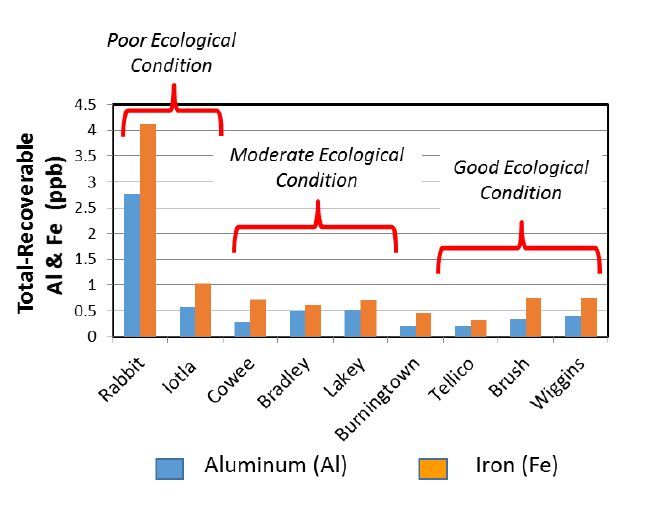1. Introduction
The Upper Little Tennessee River (ULTR) flows approximately 90 km downstream from its headwaters in northwestern Georgia across western North Carolina to Fontana Lake near the Tennessee border (Figure 1). The ULTR is an extremely important aquatic resource as it possesses one of the most diverse assemblages of aquatic biota in the United States. A total of 26 species of aquatic biota are considered to be rare at some level [1], including the endangered Appalachian elktoe (Alasmidonta raveneliana), the littlewing pearlymussel (Pegias fabula), and the threatened spotfin chub (Erimonax monachus).
In September 2004 two hurricanes (Frances and Ivan) tracked over the region within about a week of each other, producing a prolonged runoff event (592 cm) that represents the second largest flood on record within the ULTR (the flood record extends to 1945). Prior to the 2004 event approximately 700 Appalachian elktoe mussels were identified along a short reach of the river immediately below the dam at Lake Emory (Figure 1), and elktoe populations were considered to be exceptionally healthy (J. Fridell, USFWS, Asheville, NC, personal communications). Following the 2004 event hundreds of mussels including Appalachian elktoe were found dead (M. Cantrell, USFWS, Asheville, NC personal Communication). The populations by 2006 had decreased by approximately 80% (J. Fridell, USFWS, Asheville, NC, personal communications), and more recent surveys conducted by the NC Wildlife Resource Commission, Conservation Fisheries Inc., and the US Fish and Wildlife Service show that the Appalachian elkoe populations have yet to recover. Numerous hypotheses have been put forth to explain the cause of the decline, including: (1) habitat degradation associated with increased levels of sedimentation, (2) an increased frequency and/or duration of high turbidity flows, (3) an increase in disease or parasites, (4) changes in the competition with other species, and/or (5) the potential toxicity associated with the mobilization of contaminated sediments that were either eroded and flushed downstream from Lake Emory, or were flushed into the river from upland areas [1]. With regards to the latter, Cu derived from the use of Cu-based pesticides within the catchment was of particular concern.
In June 2010 a total of 68 channel bed sediment samples were collected from 15 tributary and 33 axial channel sites located along the ULTR between Lake Emory and Fontana Lake (Figure 1) to conduct a reconnaissance level analysis of the potential impacts of toxic trace metals on aquatic biota [2]. The analyses revealed that total sediment-associated copper (Cu), chromium (Cr), nickel (Ni), and zinc (Zn) concentrations within the channel bed sediments of the ULTR locally exceeded threshold and probable effect guidelines for aquatic biota put forth by MacDonald et al. [3], suggesting that toxic trace metals could have potentially impacted the Appalachian elktoe. However, metal speciation analyses of channel bed and Lake Emory sediments found that Cu, Cr, and Zn were largely associated with the residual, non-available sediment phase. In addition, trace metal concentrations were lower in mussel shells from the ULTR than in mussels from the Tuckasegee River, an adjacent control site with intact populations. Thus, the potential impacts of trace metals, including Cu, as based on an examination of the sediments was inconclusive.
The focus by Miller and Mackin [2] on channel bed sediments stems from the fact that they often provide an estimate of the average metal concentrations transported through a river over periods of months to a few years. A more direct approach is to characterize that concentrations of trace metals within the water column and to which aquatic biota are exposed. The disadvantage of this latter approach is that concentrations are highly variable through time, often increasing or decreasing as a function of discharge and the associated variations in suspended sediment concentrations, water chemistry, and a host of other parameters. Documenting metal concentrations within the water column therefore requires the collection and characterization of multiple water samples over a range of flow conditions.
The primary objective of this investigation was to expand upon our earlier assessment of the potential role that Cu and other toxic trace metals played in the post-2004 population declines of the Appalachian elktoe by analyzing the dissolved and total-recoverable concentrations of four trace metals (Cu, Cr, Ni, and Zn) in river waters. These four metals were focused upon because they frequently exceeded threshold effect concentrations within channel bed and Lake Emory sediments. The water samples were collected at the Needmore USGS gaging station (Figure 1) during three separate flood events. In addition, we collected water samples from nine tributaries to the ULTR and at the Needmore gaging station during a short-time period characterized by semi-uniform flow conditions to assess spatial variations in trace metal concentrations within the ULTR. This latter dataset provides insights into whether tributary basins characterized by agriculture and other human activities serve as the predominant source of metals to the axial channel of the ULTR.
2. Materials and methods
Two sets of twenty-four grab samples were collected at the Needmore gaging station (Figure 1) along the ULTR during three separate flood events between 2 October 2012 and 1 February 2013. All samples were collected from the upper 50 cm of the flow immediately adjacent to the USGS gaging station. The channel bed at the site is dominated by bedrock and the flow is highly turbulent. Thus, it was assumed that both suspended sediment and the dissolved metal concentrations were homogeneously distributed across the channel, and that the samples were representative of concentrations within the water column at the time of sampling. Samples during all three events were collected during both rising and falling flood stages. Discharge at the time of sampling was obtained online from the USGS gaging station.
Upon collection, approximately 250 mL of each sample was passed through a 0.45 µm medium capacity filter using a peristaltic pump and placed in a pre-cleaned (acid washed) polyethylene bottle. An additional 250 mL of water and sediment were placed in a separate bottle for total-recoverable metals analysis. Both were acidified with approximately 2 mL of 10% nitric acid, and “double-bagged” in plastic sampling bags. Water samples were also collected using a DH-48 sampler for suspended sediment concentration (SSC) analysis at the time that the water samples for metals analysis were obtained.
The geochemical samples, including field blanks, were analyzed for a suite of four trace metals (Cu, Cr, Ni, and Zn) using a Perkin Elmer Optima 4100DV ICP-OES. The focus on these four elements is related to their relatively high concentrations within channel bed and Lake Emory sediments [2], which exceeded aquatic threshold criteria. In addition, selected samples were analyzed for iron (Fe) and aluminum (Al) as possible sediment tracers of subsurface soil horizons. Sample analysis for dissolved and total-recoverable metals followed the USEPA method 200.8 [4].In general, dissolved samples were analyzed as collected in the field, whereas the samples for total metals were treated with a mixture of 1:1 nitric and hydrochloric acid, heated, refluxed and then brought to volume. They were then centrifuged (after they had cooled) and analyzed. Calibration was performed using CPI International multi-element standards which are certified against National Institute of Standards and Technology (NIST) 3100 series standard reference materials (SRMs). Along with a reagent blank, the analyte concentrations for these standards were plotted against blank-subtracted integrated peak areas, and the resulting regression line was used to quantify unknown sample concentrations. Deviation of standards from this regression line was used to estimate analytical accuracy, replicate analyses were performed on a subset of samples to determine analytical precision, and analyses of reagent blanks were used toestimate lower limits of detection. Precision (based on replicate analyses) and accuracy were generally within ±5%.
Water samples collected for SSC analysis were analyzed using a slightly modified version of the procedure developed by Guy [5]. The detection limit was determined to be 2.5 µg/L. Precision and accuracy were determined using an in-house standard and known SSC values and were generally <±5%.
A second round of water sampling for both dissolved and total-recoverable metals analyses was conducted on 16-17 June 2015. These samples were collected from the center of nine tributaries to the ULTR between Franklin and Fontana Lake, including Bradley Creek, Brush Creek, Burningtown Creek, Cowee Creek, Iotla Creek, Lakey Creek, Rabbit Creek, Tellico Creek, and Wiggens Creek (Figure 2). A sample was also collected from the USGS gaging station at Needmore (Figure 1). Sample collection and analysis followed the procedures described above.
Discharge was also measured at each of the tributary sampling locations at the time of sampling using the USGS horizontally integrated method. Velocity was measured using a Hach digital velocity meter. The collection of discharge data allowed for the determination of instantaneous metal loads (load = discharge x metal concentration) from each of the tributaries during a relatively short time period when flow was characterized by base flow conditions.
All statistical analyses were carried out using Microsoft Excel or Origin 8.0.
3. Results and discussion
3.1. Dissolved and total trace metal concentrations
Analyses of the filtered water samples showed that dissolved concentrations of Cu, Cr, Ni, and Zn within all 24 samples for the three sampled floods were below detection. Total-recoverable concentrations measured within the unfiltered samples were consistently higher, often exceeding the North Carolina total-recoverable freshwater guidelines for potential impacts to aquatic biota [6] (Table 1). For example, 14 (58%) of the samples exceeded the freshwater guidelines for Cu and Zn. The observed percentages for Cu are similar to results obtained by the NC Department of Environment and Natural Resources between 1 September 1994 and 31 August 1999 at both the Needmore and Prentiss gaging stations [7], the latter located upstream of the study area. At the Needmore gage, 16.7% of the 54 analyzed samples exceeded 19 µg/L; at the Prentiss gage, 18.9% of the 53 analyzed samples exceeded 21 µg/L [7]. Two (8.3%) of the samples collected and analyzed during this study exceeded the North Carolina guidelines for Cr, whereas no samples exceeded the North Carolina guidelines for Ni. Thus, the water quality data suggest that the primary elements of concern are Cu and Zn.
Table 1. Number and percentage of samples that exceed the total-recoverable North Carolina freshwater guideline for potential impacts on aquatic biota
|
Metal
|
North Carolina1
(total recoverable) (µg/L)
|
# of Samples
Exceeding NC Standard
|
% of Samples
Exceeding
NC Standard
|
| Copper (Cu)
|
7
|
14
|
58
|
| Chromium (Cr)
|
50
|
2
|
8.3
|
| Iron (Fe)
|
1000
|
23
|
95.8
|
| Nickel (Ni)
|
88
|
0
|
0
|
| Zinc (Zn)
|
50
|
14
|
58
|
| 1NC Freshwater standard [7] |
The relatively low percentage of samples that exceeded freshwater guidelines for Cr and Ni in the water samples was somewhat surprising given that (1) 82.6% of the sediment samples collected along the margins of the ULTR exceeded the threshold concentrations put forth by MacDonald et al. [3] for Ni, and (2) the concentrations of Cu, Ni, and Zn in sediment from the ULTR exhibited moderate (0.47 to 0.79), but statistically significant correlations [2]. The limited number of samples exceeding the freshwater guideline for Ni may be due differences in how the guidelines were developed for sediments and water.
Significant correlations between metal concentrations are often used to indicate a common source and/or similar dispersal mechanisms [8]. In this case, total-recoverable Cu, Cr, Ni, and Zn concentrations exhibited statistically significant correlations (p ≤ 0.01). The total concentration of all four metals was also correlated with suspended sediment concentrations (SSC), suggesting that metals are primarily sorbed to particle surfaces (Table 2). Thus, it appears in general that these four metals are derived from a similar source and transported with particulate matter through the ULTR.
Table 2. Correlation matrix of selected metal and SSC concentrations. Correlation coefficients are statistically significant (p ≤ 0.01)
|
|
SSC
|
Cr
|
Cu
|
Ni
|
Zn
|
| SSC
|
1.00
|
|
|
|
|
| Cr
|
0.87
|
1.00
|
|
|
|
| Cu
|
0.85
|
0.98
|
1.00
|
|
|
| Ni
|
0.79
|
0.97
|
0.97
|
1.00
|
|
| Zn
|
0.80
|
0.87
|
0.86
|
0.83
|
1.00
|
3.2. Variations in total metal concentrations with discharge
By definition the total concentration of an element in riverine waters is the sum of the dissolved concentration and the concentration associated with particulate matter. The latter is a function of two parameters, the SSC of the water, and the concentration of the element on the suspended particles. Thus, variations in total-recoverable elemental concentrations during a runoff event is related to (1) a change in the dissolved concentration of the element in the water, (2) an increase or decrease in SSC, (3) an increase or decrease in the average concentration of the element on the suspended particles, or (4) a combination of one or more of the above [9]. While dissolved trace metal concentrations and SSC are relatively easy to measure, directly determining the concentration of the metals on the particulates often proves difficult because large volumes of water must be filtered to collect enough suspended sediment for geochemical analysis. As a result, the concentration associated with particulates (i.e., the particulate load) is typically determined by subtracting the dissolved concentration from the total-recoverable measured concentration. The approach is far from perfect (see Miller and Orbock Miller [8] for a discussion), but allows for an assessment of how both the dissolved and particulate concentrations change through time and the factors that lead to these variations.
In the case of the ULTR, the calculation is based on dissolved concentrations that were below detection and relatively high total-recoverable metal concentrations. The contrasting results suggest that nearly all of the metals are associated with suspended sediments. The association of metals with fine-grained suspended particles is not surprising given that previous studies have found that more than 90% of the total trace metal load is typically transported through rivers in the particulate phase (see Miller and Orbock Miller [7] for a review). The finding suggests that factors that typically influence dissolved concentrations, such as variations in pH, redox conditions, temperature, and presences of various complexing agents [2,10] are likely to be of less importance in controlling temporal variations in total metal concentrations than the influence of altered discharge conditions, and its influence on suspended sediment loads, during a runoff event. In fact, total-recoverable metal concentrations exhibited a statistically significant increase with discharge for both the combined data (Figure 3) and for individual floods.
At the event scale, while total-recoverable metal concentrations exhibited a strong tendency to increase with discharge, the trends were characterized by significant hysteresis. Hysteresis represents a condition in which concentration for a given discharge magnitude differ between the rising and falling stage of an event. It occurs because the peak in discharge and elemental/sediment concentration do not occur at the same time. The form of the hysteretic loops was generally consistent between metals, but varied between events (Figure 4). Williams [11] notes that the nature of these loops with regards to suspended sediments depends on a large number of factors including (1) the intensity and areal distribution of precipitation within the basin, (2) the amount and rate of runoff, (3) the quantity of sediment stored within and along the channel, and (4) differences in the source and rate of downstream sediment transport.
Hysteresis for most events, such as flood #3 (30 January-2 February 2013), was characterized by a clockwise loop (Figure 4). Clockwise loops as applied to suspended sediments and the metals sorbed to them are most often produced by the rapid mobilization of easily eroded sediment during the early stages of the event, a phenomenon referred to as the “first flush”. Once these easily eroded sediments from both upland areas and the channel are depleted, SSCs measured within the water decrease resulting in lower constituent concentrations for a given discharge during the falling limb of the hydrograph.
The hydrology of flood event #2 (14-21 January 2013) was more complex as it was produced by rainfall that periodically occurred over several days, and was characterized by two peaks in discharge spaced approximately 48 hours apart (Figure 5). While the variations in rainfall produced temporal trends in discharge and total-recoverable metal concentrations that are more complicated than those observed for event #3, the initial stage of the event was characterized by a clockwise loop which was disrupted by an increase in concentrations as rainfall and discharge rose for a second time (Figure 4).
Given that both SSC (Figure 6) and total-recoverable metal concentrations (Figure 3) exhibited statistically significant correlations to discharge, at least part of the changes in trace metal content of the water during an event was likely due to changing suspended sediment loads. As noted above, however, it is possible that the concentration of trace elements on the particles changed as well. In order to assess such changes in sediment-associated trace element concentrations, the average concentration associated with the suspended particles was determined using the following equation (Horowitz et al., 2001):
|
SPC = (TSCsusp/SSC) * 1000
|
Equation 1
|
where SPC (mg/kg) is the trace metal concentration of the particles, TSCsusp (mg/kg) is the total-recoverable trace metal concentration measured in the river water, and SSC is the suspended sediment concentration (mg/L).
Mean particle-associated concentrations (SPC) of Cr, Cu, and Ni were determined to be similar to the mean concentrations measured by Miller and Mackin [2] for the channel bed sediment (Tables 1, 3). However, the particle-associated concentrations for Zn was well above those measured in the channel bed. The range of values measured for all of the elements was also larger, varying by an order of magnitude (Table 3). In addition, there was a weak tendency (R2 values ranging from 0.14 to 0.64) for particle-associated trace metal concentrations to decline with increasing discharge when data from all three events were combined (Figure 7). For example, for those samples where Cu concentrations were measureable, Cu content declined from a high of 726 to 32.3 mg/kg with increasing discharge (Figure 7). More variability was observed between Ni and Zn concentrations and discharge, but the trend is still apparent (Figure 7).
Table 3. Summary of Trace Metal Concentrations of Suspended Particles (TMSp)
|
|
TMSp
Mean
(µg/g)
|
TMSp Range
(µg/g)
|
ULTR (mean)
|
Crustal Averages
|
Guideline Values
|
|
Axial1
(µg/g)
|
Edge2
(µg/g)
|
Granite
(µg/g)
|
Shale
(µg/g)
|
CB-TEC3
(µg/g)
|
CB-PEC4
(µg/g)
|
| Cu
|
134
|
32.3-726
|
134
|
347
|
20
|
45
|
31.6
|
149
|
| Cr
|
89.9
|
36.9-181
|
62.2
|
101
|
10
|
90
|
43.4
|
111
|
| Ni
|
45.3
|
4.61-121
|
21.9
|
41.0
|
10
|
68
|
22.7
|
48.6
|
| Zn
|
636
|
122-1593
|
92.3
|
23.3
|
50
|
95
|
121
|
459
|
| 1Mean (range) of axial channel bed sediments (from 1Miller and Mackin [2]); 2Mean (range) of channel edge/margin sediments (from Miller and Mackin [2]); 3Concensus based threshold concentration provided by MacDonald et al. [3]—level at which negative aquatic impacts to biota may occur; 4Concensus based probable effect threshold concentration provided by MacDonald et al. [3]—level at which negative aquatic impacts to biota are likely to occur. |
The data presented above suggest that the complex variations in total trace metal concentrations during an event were dictated in part by the first-flush phenomena that allowed for the transport of easily eroded sediments to rapidly increase SSC, and therefore total-recoverable trace metal concentrations, in the river during the onset of the event. The variations in total-recoverable trace metal concentrations cannot, however, be completely explained by variations in SSC as there is a weak tendency for particulate-associated trace metal concentrations to decrease during a flood (Figure 7). We hypothesize that the observed variations in particulate-associated trace metal concentrations reflect changes in the size distribution of the suspended particles. During low flow, the suspended sediment is presumably dominated by clay- and, perhaps, fine silt-sized sediment characterized by relatively high trace metal concentrations. Such fine particles have often been observed to exhibit relatively high metal contents due to their increased surface area and their more chemically reactive nature [2,12,13,14]. As discharge increases coarser-grained sediments characterized by less chemically reactive particles (e.g., quartz and feldspar) are entrained. These larger particles dilute and decrease the concentration of the metals within the suspended sediment. Unfortunately, the quantity of suspended sediment collected in the SSC samples was too small for quantitative grain size analysis, even by a laser particle size analyzer. However, visual inspections of the filter papers revealed that samples characterized by higher SSCs, and collected during higher flow conditions, exhibited larger proportions of sand-sized sediment.
The observed variations in total-recoverable trace metal concentrations are significant in terms of both the monitoring of site conditions and the assessment of the potential biological impacts of metal contaminants. With regards to monitoring, higher total-recoverable metal concentrations are likely to be observed for samples collected during the rising stage. Collecting samples only during the rising or falling stages of the hydrograph will tend to bias the dataset. In addition, the observed hysteresis effects, which appear to have involved the selective transport of fine material during the first flush phenomena, indicates that long periods of highly elevated metal concentrations are less likely to occur (Figure 4). Rather, concentrations may decline shortly after the first flush, thereby limiting the exposure of biota to highly elevated levels of trace metals.
3.3. Potential source(s) of trace metals
It has become increasingly clear that high concentrations of metals in streams and lakes can be derived from the oxidation of sulfide minerals (e.g., pyrite, arsenopyrite, galena, and sphalerite) contained in the underlying bedrock in both mineralized [15,16,17] and unmineralized [18,19] regions. Sulfide oxidation has two impacts on water quality: (1) it increases the acidity (lowers pH) of the water, leading to a phenomena referred to as acid rock drainage (ARD), and (2) it releases toxic metals, which tend to be more soluble in acidic conditions, into the water. As an example, the oxidation of pyrite can be described by the following summary equation:
The oxidation of pyrite is actually a multi-step process and, thus, more complex than that shown in Equation 2. However, Equation 2 shows that for every mole of pyrite oxidized, two moles of sulfuric acid are produced, along with 1 mole of ferric hydroxide.
ARD is of particular importance in areas underlain by black shales enriched in sulfides [16,20,21,22], and terrains characterized by metasedimentary sequences enriched in sulfide minerals, such as Nova Scotia [23,24,25,26]. Oxidation is most pronounced when bedrock containing sulfide minerals is exposed to the atmosphere or, more commonly, oxygenated waters either by natural processes (e.g., a landslide) or by anthropogenic activities (e.g., excavation during construction). Following exposure, oxidation can occur rapidly and the combination of lowered pH and increased concentrations of metals have been shown to negatively impact aquatic biota, in many instances leading to fish kills [18,24,26].
Bedrock underlying the ULTR basin is composed of metamorphic rocks including biotite gneisses, schists, and other metasedimentary sequences that contain extensive zones of sulfide mineralization [27], and the oxidation of these sulfides has impacted aquatic biota. Oxidation of sulfides contained within the Anakessta Formation, for example, has been shown to lower pH within the Great Smoky Mountain National Park [28,29,30], and has led to fish kills following exposure during road construction [18].
Miller and Mackin [2] used several lines of evidence to suggest that the majority of trace metals contained in the channel bed of the ULTR as well as in Lake Emory (Figure 1) were primarily derived from the sulfidic zones within the underlying bedrock and/or the soils developed in it. Their evidence included the following:
(1) Metal speciation data showed that the majority of the metals were associated with the residual phase (e.g., oxidizable oxides and sulfides);
(2) Downstream trends in sediment-associated metal concentrations within the channel bed reflected inputs from areas of bedrock exposure; and
(3) A two-step, geochemical mass balancing model found that the relative contribution of sediment as well as sediment-associated Cu and Zn to the axial channel were higher from upstream tributary basins in poor to moderate ecological condition, and that were prone to significant erosion, than from downstream tributaries that were in high ecological condition (Figure 2).
In addition, concentration-depth profiles constructed from cores extracted from Lake Emory showed, with the exception of Cu, that the highest metal concentrations, sedimentation rates, and influx occurred immediately after dam closure in 1923. Metal concentrations had declined significantly by 1963. They argued that the vertical trend was due to the erosion of metal enriched subsurface soil horizons during a period of deforestation in the early to mid-1900s, followed by reforestation and the implementation of erosion mitigation practices within the catchment. The one exception was Cu which exhibited a systematic upward increase in concentrations within the core. They attributed the upward increase in Cu concentrations to the increasing use of Cu-based pesticides within two tributary basins (Rabbit and Cat Creeks) that drain into Lake Emory. However, they found that Lake Emory had primarily served as a sediment sink that reduced the transport of fine sediment to downstream reaches of the ULTR.
In light of the above, water samples were collected during this study from the mouth of nine tributaries for dissolved and total-recoverable metals analyses. The sampled basins are representative of the range of land-use practices and ecological conditions of catchments that are tributary to the ULTR (Table 4). Sampling occurred on 16-17 June 2015 during base flow. Base flow was selected because it can often be used as an indicator of constituent influx into the river from groundwater sources. With the exception of Zn, the dissolved and total-recoverable concentrations of the metals examined during base flow conditions were below detection. Total Zn concentrations ranged from non-detectable to 0.128 µg/L; the mean was 0.094 µg/L. While detectable, Znconcentrations were well below the NC freshwater guidelines for aquatic biota [6]. The observed metal concentrations presumably reflect the limited influx of metals from groundwater (that supplied the base flow), and the limited transport of suspended sediment during base flow conditions within the tributaries.
Table 4. Summary of Tributary Basin Characteristics
| Tributary Basin
|
Drainage
Area (km2)
|
%
Developed
|
% Row Crops
|
% Pasture
|
% Forested
|
Ecological1 Condition
|
|
Rabbit Cr.
|
17.4
|
11.0
|
.02
|
12.1
|
26.3
|
Poor
|
|
Cowee Cr.
|
13.4
|
6.4
|
0.0
|
12.8
|
80.1
|
Moderate
|
|
Iotla Cr.
|
25.7
|
9.2
|
0.2
|
17.1
|
74.1
|
Poor
|
|
Bradley Cr.
|
12.0
|
6.8
|
0.9
|
11.4
|
79.5
|
Moderate
|
|
Lakey Cr.
|
11.1
|
5.3
|
0.0
|
11.3
|
82.9
|
Moderate
|
|
Burningtown Cr.
|
69.1
|
2.6
|
0.0
|
3.3
|
93.9
|
High
|
|
Tellico Cr.
|
33.2
|
1.9
|
0.0
|
0.8
|
97.1
|
High
|
|
Brush Cr.
|
22.2
|
3.4
|
0.0
|
2.1
|
93.4
|
High
|
| Data from Ecosystem Enhancement Program [35]; data unavailable for Wiggins Cr; Cu-based pesticides is primarily associated with areas characterized by row crops. See Figure 2 for tributary locations. |
The limited influx of metals to the ULTR from groundwater may seem inconsistent with the argument that the metals are primarily derived from bedrock sources. Nordstrom (2009), for example, suggested that for many rivers, particularly those located in arid regions, metal concentrations in riverine waters will slowly increase during long dry spells. Concentrations may then increase significantly during the early phases of a runoff event in response to the dissolution of soluble salts formed during the dry period and the flushing out of pore waters that were concentrated during evaporation.
The ULTR basin is characterized by relatively high annual rainfall which limits the formation of soluble salts (mean annual rainfall ranges from ~130 to 215 cm depending on elevation). The lack of base cations within the water is demonstrated by specific conductivity values within the region that vary little between base flow and stormflow conditions and that are generally <50 µS/cm in many instances; values on the order of 15-20 µS/cm are common [30,31].
The oxidation of sulfide minerals by subsurface waters will continue until all of the minerals are fully weathered, a process which may require hundreds to thousands of years [17]. However, the concentration of metals released during oxidation may be reduced along the flow path by various attenuation processes [32], such as the precipitation of Fe-hydroxides and/or sorption onto Fe-oxyhydroxides and organic matter (note that the oxidation of pyrite, as shown in Equation 2, may result in insoluble ferric hydroxide). The attenuation of trace metals by Fe and organic matter is suggested by several observations. First, metal sediment speciation data presented by Miller and Mackin [2] shows that the majority of Cu, Cr, and Zn was associated with the organic and residual fractions. The residual fraction includes Fe oxides and sulfides (i.e., those that are not easily reducible). Second, fractures within the bedrock as well as exposed bedrock and clasts within the channel are frequently characterized by strong Fe staining (e.g., by goethite and limonite), and Fe is a major constituent in the local soils. Third, concentrations of Cu, Cr, Ni, and Zn within the total-recoverable water samples are correlated to Fe concentrations (Figure 8), demonstrating that the metals are closely associated with particulate Fe.
Figure 8 shows, however, that the relationship between Fe and the four trace metals as well as SSC forms two distinct trends. The trend characterized by relatively high Fe concentrations (and a lower slope) consists of samples that were typically associated with low to moderate discharge conditions (beginning and, to a lesser degree, ending of an event), whereas samples forming the second trendline were collected during higher flow. The distinct trends are consistent with the observed hysteresis effects associated within individual events (Figure 4) in that low to moderate flows during the early stages of an event are characterized by higher and rapidly increasing metal concentrations. The association of the metals and SSC with Fe suggest that their increase in concentration is due in part to the rapid entrainment and/or influx of very fine-grained particulate Fe that becomes diluted during the influx of larger, less reactive particles later in the flood. Kimball et al. [33] observed a similar rapid flushing of Cu (and Fe) along the Merse River, Italy, which they also attributed to the rapid suspension of colloidal Fe to which the Cu was sorbed.
The low concentrations of trace metals within the tributaries during base flow may also be due to the nature of the groundwater system. The bedrock, composed of metamorphic rocks, is characterized by fracture flow. Porosity and permeability of the rock in general is very low. As a result, flow through the bedrock (which presumably contains higher quantities of unweathered sulfide minerals) is likely to be relatively small in comparison to flow through the upper weathered saprolitic bedrock, or the colluvial and alluvial materials that rest upon it. In addition, soils in the basin are characterized by high concentrations of Fe and Al oxides and hydroxides, to which trace metals derived from the oxidation of sulfide minerals appear to be sorbed. Metal concentration data for soils within or immediately adjacent to the basin are limited. However, the data that exist show that while concentrations are highly variable, they are consistent with the concentrations observed for sediments within the ULTR [2], and often show an increase in depth below the ground surface [34].
An important finding is that total Fe and Al concentrations measured in nine tributaries to the ULTR were high, and exhibited a semi-systematic downstream decline among the analyzed tributaries. The maximum concentrations of both Fe and Al occurred within Rabbit and Iotla Creeks (Figures 2, 9), which were categorized to be in poor ecological condition [35]. Intermediate concentrations were generally associated with tributaries in moderate ecological condition, while the lowest values were observed for basins in good (high) condition (although there was some overlap between tributaries in the last two categories). Assuming that the trace metals are associated in part with particulate Fe, and that the Fe is derived from the erosion of subsurface soil horizons, the data are consistent with the mass balance modeling results presented by Miller and Mackin [2] that suggested that Cu, Zn, and suspended sediments are primarily derived from extensively eroded catchments in poor ecological condition.
4. Conclusions
Dissolved Cr, Cu, Ni, and Zn concentrations were generally below detection, whereas approximately 60% of the samples exceeded North Carolina freshwater guidelines for total-recoverable Cu and Zn. The total recoverable concentration of all four trace metals were directly correlated to SSC, indicating that most of the metals are being transported through the river in association with particulate matter. As SSC increased with discharge, metal concentrations also tended to increase. During individual events, variations in metal concentrations for a given discharge were influenced by hysteresis associated with the first flush phenomenon. The rapid increase in metal concentrations during the early stages of an event appears to be related to the entrainment of fine sediment, including particulate Fe to which the metals are sorbed. Decreasing concentrations later in the event are likely to be due to the entrainment of coarse-grained, less reactive particles, a reduction in the availability of easily erodible sediment, and dilution associated with the influx of sediment characterized by lower metal concentrations. The majority of the metals appear to be derived from the erosion of sediment and particulate Fe from subsurface soil horizons developed in bedrock containing sulfidic layers. Erosion is particularly pronounced in tributary basins that are in poor to moderate ecological condition. Given that the input of these metal-enriched sediments was likely to be much higher during the period of deforestation near the turn of the 20th century [2,36,37], and were elevated prior to the decline of the elktoe mussel in 2004, it seems unlikely that toxic trace metals significantly impacted their populations. However, it is possible that local hillslope and valley bottom erosion caused by the 2004 flood exposed zones of unweathered or slightly weathered bedrock and sediment containing significant quantities of sulfide minerals. The exposure of these units, and the subsequent oxidation of sulfide minerals, could potentially have lowered the pH of the river waters which were already characterized by acidic conditions, thereby negatively impacting the aquatic biota.
Acknowledgements
Mr. Jacob Sinclair and Mr. Kenneth Walton provided significant support in the collection of the water samples. Mr. Sinclair was also instrumental in analyzing the water samples. Their help is greatly appreciated. The text benefited greatly from the comments provided by Ms. Suzanne Orbock Miller, and two anonymous reviewers. Any shortcomings within the analysis are, of course, mine and do not reflect the suggestions provided during the review. Financial support for the project was provided by the US Fish and Wildlife Service under agreement number 40181AG059. The conclusions reached in this analysis do not necessarily reflect the views of the US Fish and Wildlife Service.
Conflict of interest
The author has no conflict of interest to report.









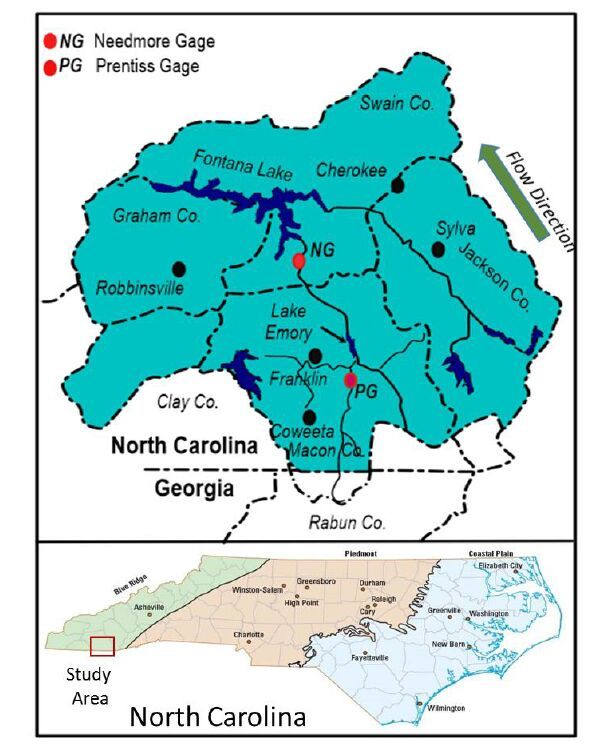
 DownLoad:
DownLoad: 